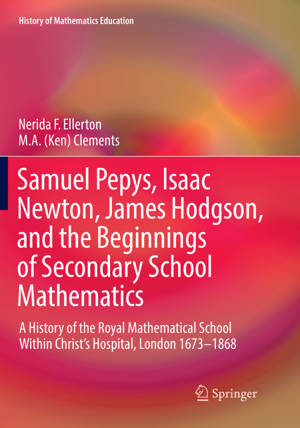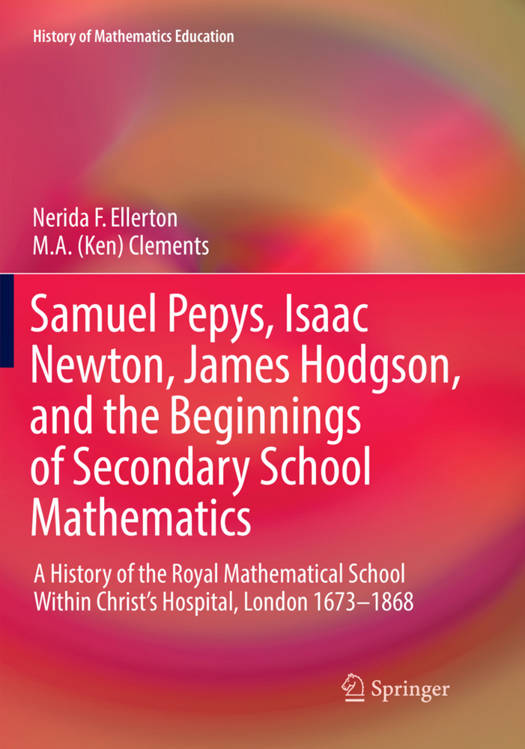
- Retrait gratuit dans votre magasin Club
- 7.000.000 titres dans notre catalogue
- Payer en toute sécurité
- Toujours un magasin près de chez vous
- Retrait gratuit dans votre magasin Club
- 7.000.0000 titres dans notre catalogue
- Payer en toute sécurité
- Toujours un magasin près de chez vous
Samuel Pepys, Isaac Newton, James Hodgson, and the Beginnings of Secondary School Mathematics
A History of the Royal Mathematical School Within Christ's Hospital, London 1673-1868
Nerida F Ellerton, Clements
167,95 €
+ 335 points
Format
Description
This book tells one of the greatest stories in the history of school mathematics. Two of the names in the title-Samuel Pepys and Isaac Newton-need no introduction, and this book draws attention to their special contributions to the history of school mathematics. According to Ellerton and Clements, during the last quarter of the seventeenth century Pepys and Newton were key players in defining what school mathematics beyond arithmetic and elementary geometry might look like. The scene at which most of the action occurred was Christ's Hospital, which was a school, ostensibly for the poor, in central London. The Royal Mathematical School (RMS) was established at Christ's Hospital in 1673.
It was the less well-known James Hodgson, a fine mathematician and RMS master between 1709 and 1755, who demonstrated that topics such as logarithms, plane and spherical trigonometry, and the application of these to navigation, might systematically and successfully be taught to 12- to 16-year-old school children. From a wider history-of-school-education perspective, this book tells how the world's first secondary-school mathematics program was created and how, slowly but surely, what was being achieved at RMS began to influence school mathematics in other parts of Great Britain, Europe, and America.
The book has been written from the perspective of the history of school mathematics. Ellerton and Clements's analyses of pertinent literature and of archival data, and their interpretations of those analyses, have led them to conclude that RMS was the first major school in the world to teach mathematics-beyond-arithmetic, on a systematic basis, to students aged between 12 and 16.
Throughout the book, Ellerton and Clements examine issues through the lens of a lag-time theoretical perspective. From a historiographical perspective, this book emphasizes how the history of RMS can be portrayed in very different ways, depending on the vantage point from which the history is written. The authors write from the vantage point of international developments in school mathematics education and, therefore, their history of RMS differs from all other histories of RMS, most of which were written from the perspective of the history of Christ's Hospital.
It was the less well-known James Hodgson, a fine mathematician and RMS master between 1709 and 1755, who demonstrated that topics such as logarithms, plane and spherical trigonometry, and the application of these to navigation, might systematically and successfully be taught to 12- to 16-year-old school children. From a wider history-of-school-education perspective, this book tells how the world's first secondary-school mathematics program was created and how, slowly but surely, what was being achieved at RMS began to influence school mathematics in other parts of Great Britain, Europe, and America.
The book has been written from the perspective of the history of school mathematics. Ellerton and Clements's analyses of pertinent literature and of archival data, and their interpretations of those analyses, have led them to conclude that RMS was the first major school in the world to teach mathematics-beyond-arithmetic, on a systematic basis, to students aged between 12 and 16.
Throughout the book, Ellerton and Clements examine issues through the lens of a lag-time theoretical perspective. From a historiographical perspective, this book emphasizes how the history of RMS can be portrayed in very different ways, depending on the vantage point from which the history is written. The authors write from the vantage point of international developments in school mathematics education and, therefore, their history of RMS differs from all other histories of RMS, most of which were written from the perspective of the history of Christ's Hospital.
Spécifications
Parties prenantes
- Auteur(s) :
- Editeur:
Contenu
- Nombre de pages :
- 325
- Langue:
- Anglais
- Collection :
Caractéristiques
- EAN:
- 9783319835556
- Date de parution :
- 18-07-18
- Format:
- Livre broché
- Format numérique:
- Trade paperback (VS)
- Dimensions :
- 178 mm x 254 mm
- Poids :
- 612 g

Les avis
Nous publions uniquement les avis qui respectent les conditions requises. Consultez nos conditions pour les avis.






